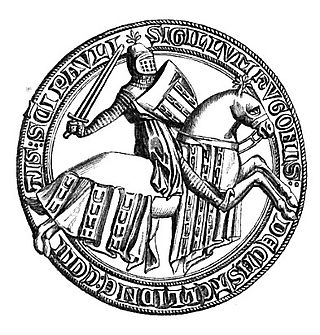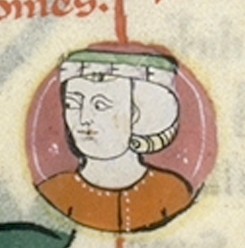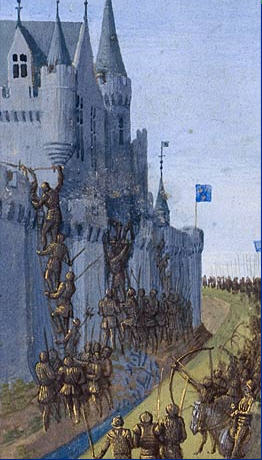Family
Isabelle (Elizabeth) was born probably before 1180. She belonged to the highest nobility of France. She was the younger daughter of Count Theobald V of Blois and Chartres and Alice, daughter of King Louis VII and the Duchess Eleanor of Aquitaine. She had a brother, Count Louis I of Blois; an older sister, Margaret; and another sister, Alice, who was the abbess of Fontevraud between 1209 and 1218. [4]
Isabelle was married twice. In 1190, she was married to Sulpice III of Amboise [ fr ]. They had six children: Hugh, Matilda, John, William, Alice and Dionysia. Sometime before 1209, Sulpice and Isabelle jointly founded the Cistercian priory of Moncé [ fr ]. When Sulpice died, sometime between 1214 and 1218, Hugh inherited Amboise. He in turn was succeeded by Matilda around 1237. The fates of the four younger children of Isabelle and Sulpice are unknown. Isabelle made several gifts to Moncé for the benefit of Sulpice's soul, including endowing a priest there to say mass daily. In 1218, she married John II [ fr ], lord of Montmirail and Oisy. [9] No children of her second marriage are known.
Countess
When Isabelle's nephew, Count Theobald VI, died without heirs in 1218, his counties were divided between his aunts. The initiative to divide them came from King Philip II. Margaret received Blois and Isabelle received Chartres. Her husband, John, paid a feudal relief to the king, who in August confirmed Isabelle's succession to the county and to some associated castellanies with her cousin, Count William II of Perche, standing as surety. In July 1221, William gave Montigny-le-Chartif to his cousin and her heirs.
In 1222, Isabelle and John founded the Cistercian nunnery of Lieu-Notre-Dame [ fr ] on her property in the castellany of Romorantin. This foundation lay on the edge of the marshy wilderness known as the Sologne and the nuns were given 36 arpents to bring under cultivation. In 1232, Isabelle's daughter Matilda and her husband, Richard II of Beamont [ fr ], granted the nuns a further 100 arpents rent free if they brought it under cultivation.
In 1226, with the help of the bishop of Chartres and the Benedictine abbot of Saint-Père-en-Vallée, Isabelle and John founded the Cistercian nunnery of Notre-Dame de l'Eau [ fr ] on land purchased from Lady Adeline of Ver. [17] Isabelle's charters for Lieu are well preserved in a cartulary compiled in 1269 or 1270, but many of those for Eau were lost in a 16th-century fire. Today, 92 of her charters for Lieu and 35 for Eau survive. Besides her own foundations, Isabelle was generous with other houses favoured by her family. She made or confirmed donations to the abbeys of Saint-Antoine-des-Champs, Notre-Dame-la-Trappe, Notre-Dame de Barbeau, Notre-Dame de Vaucelles [ fr ], Notre-Dame-des-Clairets [ fr ] and La Madeleine de Châteaudun [ fr ], as well as the almshouse of Châteaudun and the leprosarium of Grand-Beaulieu.
In 1226, William of Perche died, leaving Isabelle his share of the income from the mills of Chartres for "support of the poor". She gave it to the nunnery at Eau. Isabelle's second husband died in 1238 or 1239. [24] For the sake of his soul, she gave 435 livres tournois as alms for the poor.
In 1241, Isabelle's niece, Countess Mary of Blois, died, leaving her entire estate, including the county of Blois, to her husband, Count Hugh, and Isabelle. Hugh maintained control. In 1247, Isabelle drew up her will, confirming all her previous gifts to Lieu. [27] She also endowed a chapel there for masses to be said daily for her, her family and her cousin, Queen Blanche. In 1248, she bought back property at Saugirard, which her brother had given to the abbey of Barzelle [ fr ] before 1205, in order to bestow it on the nuns of Lieu.
Isabelle died in 1248 or 1249. She was succeeded by her widowed daughter Matilda. [29]

The Royal Abbey of Our Lady of Fontevraud or Fontevrault was a monastery in the village of Fontevraud-l'Abbaye, near Chinon, in the former French duchy of Anjou. It was founded in 1101 by the itinerant preacher Robert of Arbrissel. The foundation flourished and became the center of a new monastic Order, the Order of Fontevraud. This order was composed of double monasteries, in which the community consisted of both men and women — in separate quarters of the abbey — all of whom were subject to the authority of the Abbess of Fontevraud. The Abbey of Fontevraud itself consisted of four separate communities, all managed by the same abbess.

Marie of France was a Capetian princess who became Countess of Champagne by her marriage to Henry I of Champagne. She served as regent of the County of Champagne three times: during Henry I's absence from 1179-1181; during the minority of their son Henry II from 1181–1187; and during Henry II's absence from 1190-1197. The daughter of Eleanor of Aquitaine and Louis VII of France, she was the sister of Alice of France and the half-sister of: William IX, Henry the Young King, Richard I, Geoffrey of Brittany, Matilda of England, Eleanor of England, Joan of England, John of England; Margaret of France, Alys of France, Agnes of France, Philip II of France; and the stepdaughter of Henry II of England, and Constance of Castile, and Adela of Champagne.

Adela of Normandy, of Blois, or of England, also known as Saint Adela in Roman Catholicism, was a daughter of William the Conqueror and Matilda of Flanders who later became the countess of Blois, Chartres, and Meaux by marriage to Stephen II of Blois. Her husband greatly benefited from the increased social status and prestige that came with such a marriage. She brought with her not only her bloodline but a dowry of money and other movable goods from the prodigious store of Anglo-Norman wealth. She was regent of Blois during the absence of her spouse in 1096–1100 and 1101–02, and during the minority of her son from 1102 until 1120. Adela was the mother of King Stephen of England and Bishop Henry of Winchester.
Alice of France was countess consort of Blois by marriage to Theobald. She served as regent of Blois during Theobald's absence from in 1190–1191, and during the minority of their son Louis from 1191 until 1197. The daughter of Eleanor of Aquitaine and Louis VII of France, she was the sister of Marie of France and the half-sister of: William IX, Henry the Young King, Richard I, Geoffrey of Brittany, Matilda of England, Eleanor of England, Joan of England, John of England; Margaret of France, Alys of France, Agnes of France, Philip II of France; and the stepdaughter of Henry II of England, and Constance of Castile, and Adela of Champagne.

Blanche of Navarre was Countess of Champagne by marriage to Theobald III, Count of Champagne, and regent of Champagne during the minority of her son Theobald I of Navarre between 1201 and 1222.

Mary, Countess of Blois, also known as Marie of Avesnes, (1200–1241) was countess of Blois from 1230 to 1241.

Hugh I, Count of Blois, also known as Hugh I of Châtillon was jure uxoris Count of Blois from 1230 to 1241, and Count of Saint Pol from 1226 to 1248.

Odo II was the count of Blois, Chartres, Châteaudun, Champagne, Beauvais and Tours from 1004 and count of Troyes and Meaux from 1022. He twice tried to make himself a king: first in Italy after 1024 and then in Burgundy after 1032.

Matilda of Carinthia was a daughter of Engelbert, Duke of Carinthia and his wife Uta of Passau. She married Theobald II, Count of Champagne in 1123.

William the Simple was Count of Blois and Count of Chartres from 1102 to 1107, and jure uxoris Count of Sully.

John II, also known as Je(h)an de Nesle and by the sobriquet le Bon et le Bègue, was the tenth Count of Soissons, succeeding his father Ralph the Good, in 1235. He was the son of his father's second wife, Yolande. By marriage he also became Count of Chartres and Lord of Amboise. He was well-connected with the trouvères: his younger brother Raoul was one and he received the dedication of a song by Pierrekin de la Coupele. He was also a cousin by marriage of the historian Jean de Joinville. He is not to be confused with John II of Nesle, the burggrave of Bruges.

Peter I of Alençon was the son of Louis IX of France and Margaret of Provence.
Matilda of Amboise was the Countess of Chartres 1248-1256. She was the daughter of Sulpice III of Amboise and Isabella of Blois.
William II, count of Perche and bishop of Châlons, son of Count Rotrou IV of Perche and Matilda, daughter of Count Theobald II of Champagne and Matilda of Carinthia.
Matilda I, Countess of Nevers or Mathilde de Courtenay, or Mahaut de Courtenay, (1188–1257), was a ruling countess of Nevers, Auxerre and Tonnerre. She was the only daughter of Peter II of Courtenay and of Agnes of Nevers, born from the Capetian House of Courtenay, she was married to Hervé IV of Donzy and then to Guigues IV of Forez.

Guy IV (c. 1197 – 1226) of the House of Châtillon was the de facto count of Saint-Pol as Guy II from 1219/1223 until his death.
Elizabeth of Blois, sometimes Isabelle, was a French noblewoman, the duchess of Apulia by marriage (1143–1149) and a nun at Fontevraud.













